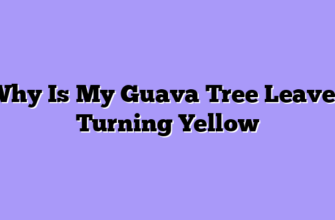Guava flower drop, also known as guava fruit drop, is a common problem faced by guava growers. It occurs when the flowers or young fruits of the guava tree fall off before they can mature, resulting in reduced yield. This phenomenon can be caused by a variety of factors, including environmental stress, nutrient deficiencies, pest infestations, and diseases. Understanding the causes of guava flower drop is crucial for developing effective management strategies to improve fruit production.
Environmental Factors
One of the most significant environmental factors contributing to guava flower drop is temperature fluctuations. Guava trees are sensitive to extreme temperatures, both high and low. During periods of prolonged heat stress, the flowers may experience physiological damage, leading to abscission. Similarly, sudden drops in temperature can also trigger flower drop, as the trees struggle to adapt to the rapid change in environmental conditions.
Another critical environmental factor is water availability. Guava trees require adequate moisture for optimal growth and flowering. However, excessive watering or prolonged periods of drought can negatively impact flower development and lead to flower drop. Water stress can disrupt the hormonal balance within the tree, causing the flowers to abort prematurely.

Light intensity is another environmental factor that can affect guava flower drop. Guava trees require sufficient sunlight for photosynthesis and flower development. However, excessive sunlight exposure can lead to heat stress and damage to the flowers, resulting in abscission. Conversely, insufficient light can hinder flower bud development and reduce the overall number of flowers produced.
Wind can also play a role in guava flower drop. Strong winds can physically damage the flowers, causing them to detach from the tree. Additionally, wind can increase transpiration rates, leading to water stress and contributing to flower abscission.
In addition to these individual environmental factors, their interactions can also influence guava flower drop. For instance, high temperatures combined with low humidity can create a stressful environment for the trees, increasing the likelihood of flower drop. Similarly, strong winds combined with water stress can exacerbate the problem.
Nutritional Deficiencies
Guava flower drop, a phenomenon observed in guava trees, is often attributed to a complex interplay of factors, including nutritional deficiencies. While various environmental and physiological conditions can contribute to this issue, understanding the role of nutrient imbalances is crucial for effective management.
- One of the primary nutrients implicated in guava flower drop is nitrogen. Nitrogen is essential for plant growth and development, particularly in the formation of chlorophyll, the pigment responsible for photosynthesis. When nitrogen levels are insufficient, the plant may struggle to produce enough energy to support flower development, leading to premature flower drop. This deficiency can manifest as stunted growth, pale green leaves, and a reduced number of flowers.
- Another crucial nutrient for guava flower production is phosphorus. Phosphorus plays a vital role in energy transfer, cell division, and root development. A lack of phosphorus can hinder the plant’s ability to absorb other nutrients, including nitrogen, further exacerbating the problem of flower drop. Symptoms of phosphorus deficiency include stunted growth, dark green leaves, and a purplish hue on the stems and leaves.
- Potassium, a nutrient essential for water regulation and disease resistance, is also implicated in guava flower drop. Potassium deficiency can lead to weakened stems and leaves, making them more susceptible to stress and disease. This, in turn, can contribute to flower drop as the plant prioritizes survival over reproduction. Symptoms of potassium deficiency include yellowing of leaf margins, wilting, and reduced fruit size.
- In addition to these macronutrients, micronutrients like zinc and boron are also crucial for healthy guava flower development. Zinc is involved in enzyme activity and chlorophyll production, while boron plays a role in cell wall formation and pollen development. Deficiencies in these micronutrients can lead to reduced flower production and increased flower drop.
- To address nutritional deficiencies and prevent guava flower drop, it is essential to conduct regular soil analysis to determine the specific nutrient imbalances. Based on the results, appropriate fertilization strategies can be implemented. Organic fertilizers, such as compost and manure, can provide a slow and steady release of nutrients, while synthetic fertilizers can offer a more immediate solution.
Furthermore, proper irrigation practices are crucial for nutrient uptake and plant health. Overwatering can lead to nutrient leaching, while underwatering can hinder nutrient absorption. Maintaining a consistent moisture level in the soil is essential for optimal plant growth and flower production.
Pests and Diseases
Understanding the underlying causes of guava flower drop is crucial for implementing effective management strategies to mitigate its impact.
- One of the primary culprits behind guava flower drop is the infestation of pests, particularly the guava fruit fly (Bactrocera correcta). This insect lays its eggs within the developing fruit, leading to larval feeding and subsequent fruit damage. The presence of these larvae triggers a hormonal response in the plant, causing the flower to drop prematurely. Similarly, other pests, such as aphids, mealybugs, and whiteflies, can also contribute to flower drop by feeding on the plant’s sap and weakening its overall health.
- In addition to pests, diseases can also play a significant role in guava flower drop. Anthracnose, a fungal disease caused by Colletotrichum gloeosporioides, is a common culprit. This disease can infect flowers, causing them to wither and drop. Other fungal diseases, such as powdery mildew and rust, can also contribute to flower drop by weakening the plant’s overall health and reducing its ability to support fruit development.
- Environmental stressors can also trigger guava flower drop. Extreme temperatures, both high and low, can negatively impact flower development and lead to premature shedding. Similarly, drought conditions can stress the plant, reducing its ability to support fruit set. Nutrient deficiencies, particularly in nitrogen, phosphorus, and potassium, can also contribute to flower drop by limiting the plant’s growth and development.
- Managing guava flower drop requires a multi-pronged approach that addresses the underlying causes. Pest control measures, such as the use of insecticides and pheromone traps, can help reduce the impact of insect infestations. Disease management strategies, including the use of fungicides and proper sanitation practices, can help prevent the spread of fungal diseases. Additionally, optimizing environmental conditions, such as providing adequate irrigation and fertilization, can help minimize stress on the plants and promote healthy fruit development.
Furthermore, cultural practices, such as pruning and training, can help improve air circulation and sunlight penetration, reducing the risk of disease and pest infestations. Selecting disease-resistant varieties and ensuring proper planting density can also contribute to reducing flower drop.
Improper Pruning
Guava trees, like many fruit-bearing plants, rely on a delicate balance between vegetative growth (producing leaves and branches) and reproductive growth (producing flowers and fruit). Pruning plays a vital role in influencing this balance. When pruning is done incorrectly, it can disrupt the tree’s natural growth patterns, leading to an imbalance that favors vegetative growth over reproductive growth. This imbalance can manifest as a decrease in flower production and an increase in leaf growth, ultimately resulting in flower drop.
One common pruning mistake that contributes to flower drop is excessive pruning. While pruning is essential for maintaining the tree’s shape and health, removing too much foliage can shock the tree and disrupt its hormonal balance. This shock can cause the tree to prioritize vegetative growth over reproductive growth, leading to a reduction in flower production. Additionally, excessive pruning can remove potential flowering sites, further contributing to flower drop.
Another pruning error that can lead to flower drop is pruning at the wrong time of year. Guava trees typically flower during specific seasons, and pruning during these periods can interfere with flower bud development. Pruning during the flowering season can remove flower buds directly, while pruning shortly before the flowering season can disrupt the tree’s hormonal balance, leading to a decrease in flower production.
Furthermore, improper pruning techniques can also contribute to flower drop. Pruning cuts that are too close to the trunk or branch collar can damage the cambium layer, which is responsible for transporting nutrients and water throughout the tree. This damage can weaken the tree and make it more susceptible to disease and pests, ultimately affecting its ability to produce flowers and fruit.
To prevent guava flower drop due to improper pruning, it is essential to adopt a balanced and strategic approach. Pruning should be done during the dormant season, when the tree is not actively growing or flowering. This allows the tree to recover from pruning stress before the flowering season begins. Pruning cuts should be made at a slight angle, just above a bud or branch, to promote healthy growth and minimize damage to the cambium layer.
Moreover, it is crucial to avoid excessive pruning. Removing only a small percentage of the tree’s foliage each year is generally sufficient to maintain its shape and health without disrupting its natural growth patterns. By following these guidelines, you can ensure that your guava tree remains healthy and productive, yielding a bountiful harvest of delicious fruit.
Stress and Age
Stress, in its various forms, can significantly impact the reproductive processes of guava trees. Environmental stressors, such as extreme temperatures, drought, or excessive rainfall, can disrupt the delicate balance of hormones and nutrients required for flower development and fruit set. For instance, prolonged periods of drought can lead to water stress, causing the tree to prioritize survival over reproduction, resulting in flower drop. Similarly, sudden temperature fluctuations or frost can damage developing flowers, leading to their premature shedding.
Furthermore, nutritional deficiencies can also contribute to flower drop. Guava trees require a balanced supply of essential nutrients, including nitrogen, phosphorus, and potassium, for optimal growth and flowering. Insufficient nutrient availability can hinder flower bud formation and development, ultimately leading to their abscission.
Age, too, plays a crucial role in the flowering and fruiting patterns of guava trees. Young trees, typically less than five years old, often exhibit a lower flowering rate and higher flower drop due to their immature reproductive system. As trees mature, their flowering capacity increases, and flower drop tends to decrease. However, as trees reach their senescence stage, their reproductive vigor declines, leading to a decrease in flower production and an increase in flower drop.
The age-related decline in flowering and fruiting is attributed to a gradual decline in the tree’s physiological processes, including hormonal balance, nutrient uptake, and photosynthetic efficiency. This decline can be further exacerbated by environmental stressors and disease pressure.
In addition to stress and age, other factors can contribute to guava flower drop. These include insect pests, fungal diseases, and improper pruning practices. Insect pests, such as fruit flies and aphids, can damage flowers and buds, leading to their premature shedding. Fungal diseases, such as anthracnose and powdery mildew, can also infect flowers and cause them to drop.
Understanding the factors contributing to guava flower drop is essential for optimizing orchard management practices. By mitigating stress through proper irrigation, fertilization, and pest control, and by selecting appropriate cultivars and planting densities, growers can enhance the flowering and fruiting potential of their guava trees. Moreover, regular monitoring of tree health and timely intervention can help minimize flower drop and maximize fruit production.
In conclusion, guava flower drop is a complex phenomenon influenced by a combination of factors, including stress and age. By understanding the role of these factors, growers can implement effective management strategies to minimize flower drop and enhance the productivity of their guava orchards. This knowledge is crucial for ensuring sustainable guava production and meeting the growing demand for this nutritious fruit.
Q&A
**1. Question:** What are the main reasons for guava flower drop?
**Answer:** Guava flower drop can be caused by a variety of factors, including **stressful environmental conditions**, **nutrient deficiencies**, **pest infestations**, **diseases**, and **improper pollination**.
**2. Question:** How does stress affect guava flower drop?
**Answer:** Stressful conditions like **extreme temperatures**, **drought**, **flooding**, and **wind damage** can cause the plant to prioritize survival over reproduction, leading to flower drop.
**3. Question:** What nutrient deficiencies can cause guava flower drop?
**Answer:** Guava trees require specific nutrients for healthy growth and flowering. Deficiencies in **nitrogen, phosphorus, potassium, calcium, and magnesium** can all contribute to flower drop.
**4. Question:** How do pests and diseases affect guava flower drop?
**Answer:** **Pests** like aphids, mealybugs, and whiteflies can damage flowers and buds, leading to drop. **Diseases** like anthracnose and powdery mildew can also weaken the plant and cause flower drop.
**5. Question:** What can be done to prevent guava flower drop?
**Answer:** **Providing optimal growing conditions**, **correcting nutrient deficiencies**, **controlling pests and diseases**, and **ensuring proper pollination** can all help prevent guava flower drop.Guava flower drop can be caused by a variety of factors, including environmental stress, nutrient deficiencies, pest infestations, and diseases. Understanding the specific cause is crucial for effective management and prevention.








